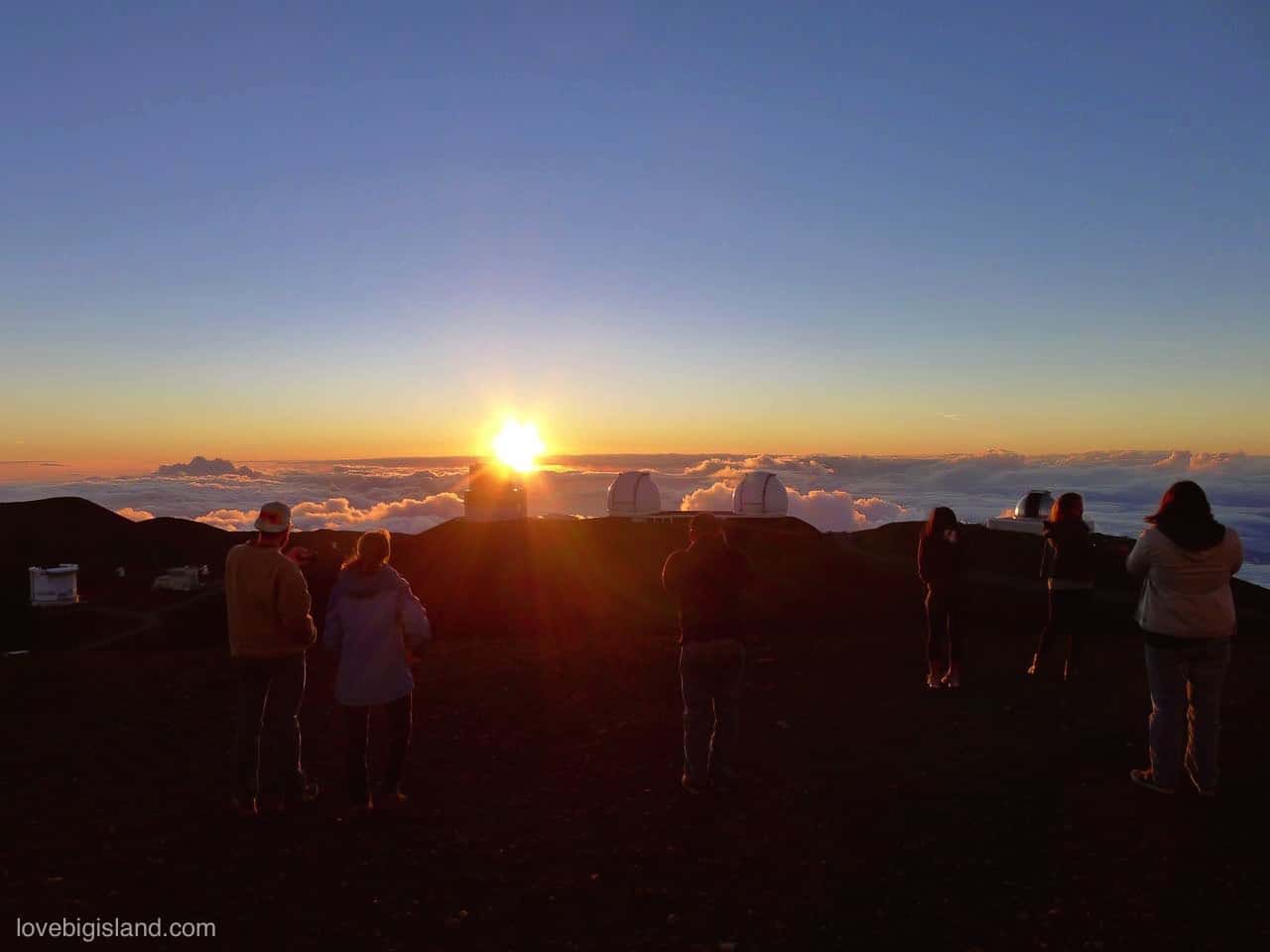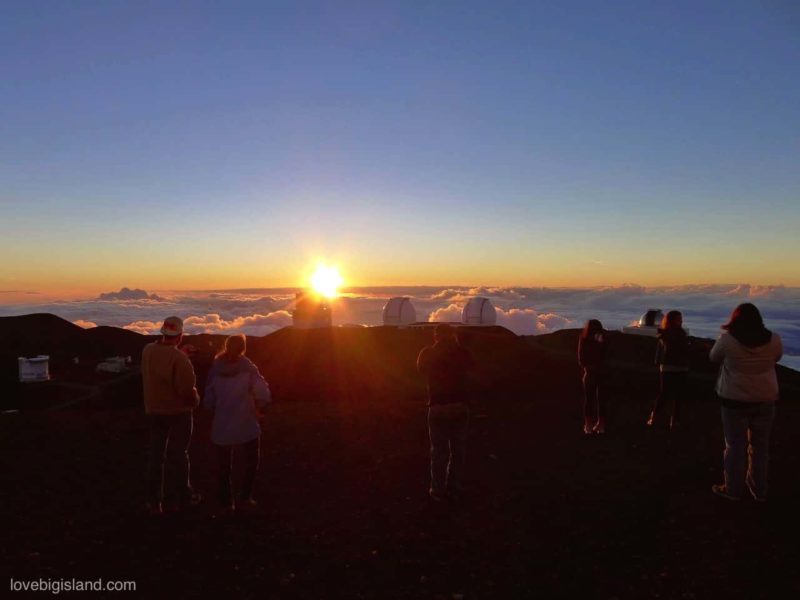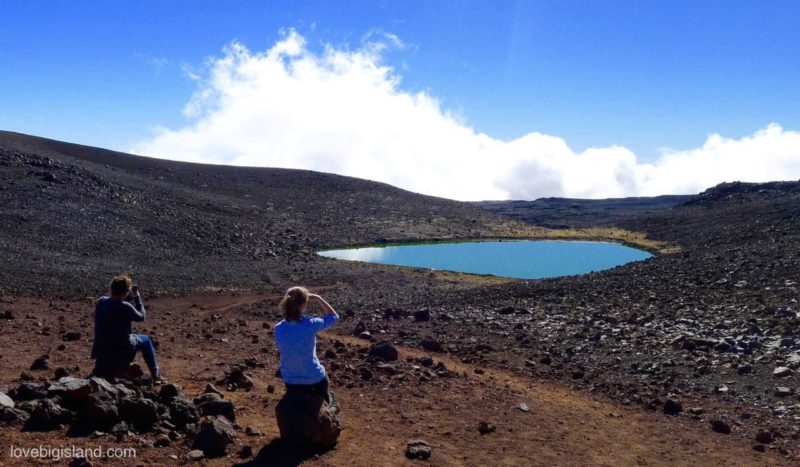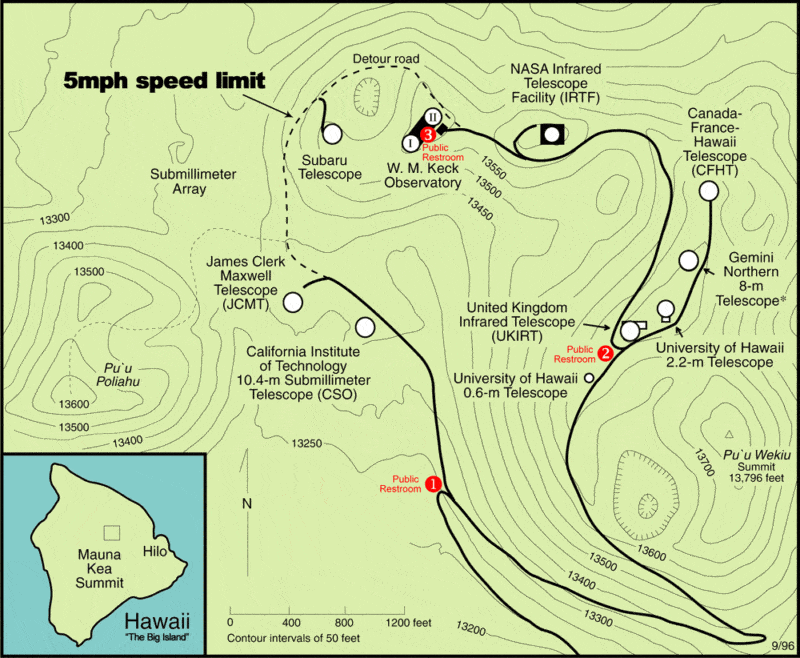The Big Island is a fantastic place for looking at the stars and hosts some of the world’s best telescopes, making stargazing a natural thing to do while here. There are a few obvious stargazing-related activities you can fit it into your itinerary ranging from a (free) nighttime picnic to an adventurous sunset visit to the summit of MaunaKea.
Table of contents
- Mauna Kea FAQ
- Stargazing Tours
- How to visit Maunakea yourself
- Getting to the MaunaKea Visitor Center (MKVIS)
- How to drive to the Maunakea summit
- Seeing the sunset: from the visitor center and from the summit.
- Learn about MaunaKea
- List of observatories on the MaunaKea summit
- What’s in a name: Mauna Kea or MaunaKea?
- Health hazards associated with being at high elevations
Table of Contents
- Mauna Kea FAQ
- Stargazing Tours
- How to visit Maunakea yourself
- Getting to the MaunaKea Visitor Center (MKVIS)
- How to drive to the Maunakea summit
- Seeing the sunset: from the visitor center and from the summit.
- Learn about MaunaKea
- List of observatories on the MaunaKea summit
- What’s in a name: Mauna Kea or MaunaKea?
- Health hazards associated with being at high elevations
In this guide we explain how you can visit the Maunakea Visitor Center and see the telescopes and sunset at the summit.
Frequently Asked Questions about visiting MaunaKea
Our MaunaKea guide is quite extensive so to save you time we have summarized the most frequently asked questions (with their answers) below:
Yes, but not with any car and only during daylight hours. On the road from the visitor center to the summit only 4WD vehicles are allowed, and the summit is off-limits from half and hour after sunset. Read more about driving to the summit here.
The free stargazing program at the Mauna Kea Visitor Center is now a monthly event and reservation are required. Read more about the free stargazing events and how to reserve here.
Yes! At 9,200ft (2,800m) elevation the visitor center is a great place for stargazing, especially if you visit during the free monthly stargazing events. The drive over Saddle Road and up to the visitor center is also highly worth it, and shows a beautiful side of Hawaiʻi. Scroll down to read more about going to the visitor center.
No 2-wheel drive vehicles will be allowed past the end of the paved road just above the VIS. Most 4WD rental agencies (except Harper’s and Big Island Jeep Rental) do not allow their vehicles to be taken up to MaunaKea. Harper’s, however, is now closed, and Big Island Jeep Rental requires a 4 day minimum rental duration. The easiest and safest way to go to the summit is to join a tour.
For astronomers yes, but for the general public the summit is strangely enough not that good. Human vision does not work that well at the high elevation of the summit, and you can see the stars better with the naked eye from the visitor center. See our list of favorite stargazing locations on all Hawaiian islands for more good stargazing spots.
Seeing the sunset from the summit is more spectacular but the visitor information center is a good alternative if you cannot make it to the summit. Click here for more information on how the see the sunset from both locations.
Do you have a question about MaunaKea that is not answered by our guide? Please get in touch with us so we can answer it for you.
MaunaKea Stargazing Tours
Tours going up Mauna Kea have several advantages over planning a visit yourself. For example, no organizing is needed from your part, tours often pick you up at your hotel, and knowledgeable guides add value with many astronomy-related facts and knowledge of the scientific and cultural significance of the summit.
Depending on your preferences there are 4 ways you can visit MaunaKea as part of a tour:
- Maunakea Summit + Stargazing Tours
- Maunakea Stargazing Tours that don’t go to the summit
- Stargazing Tours at sea level from the grounds of the Westin Hapuna Beach Resort.
- Summit tours for Hawaiʻi residents (once/month, free)
- Stargazing events at the Visitor Information Center (twice/month, free)
- Maunakea Summit + Stargazing Tours
Maunakea Summit + Stargazing Tours
There are currently seven tour operators that are permitted to take people to the MaunaKea summit. These operators are guaranteed to employ knowledgeable guides and bring their own portable telescopes. This means that you will get to experience a personal lesson in stargazing from a seasoned expert, next to a visit to the summit during the sunset.
Tours typically supply arctic parkas and thick gloves to keep you warm, snacks, and water. Depending on the tour you choose, dinner can also be included. Expect the tour to last an average of 8 hours.
Our favorite tours are organized by the professionals of Hawaii Forest and Trail because they employ knowledgeable and interpretive guides and respect the local customs and habits:
Mauna Kea Summit and Stars
A stargazing journey from sea level to the nearly 14,000 foot summit of Maunakea reveals the wonders and world-class clarity of the Hawaiian night sky. This tour lets you see the sunset among some of the world's best telescopes and then takes you for a private star show at 9000 ft. with an 11” Celestron telescope.
from:
$295
What is a suggested tour?Our suggested tours are hand-picked tours that receive consistent good reviews, give back to the community, and work hard to minimize their impact on the environment. Read more about these tours on our website.The complete list of permitted commercial tour companies is (last updated: January 2023 from source):
- Hawaii Forest & Trail (more information on our website)
- Mauna Kea Summit Adventures (website)
- Arnott’s Lodge & Hiking Adventures (website)
- Hawaiian Haoles, inc. dba Hawaiian Eyes Tours (website)
- Robert’s Hawaii Tours (currently not organizing their own tours)
- Taikobo Hawaii (English and Japanese language tours)
- Super Vacation Hawaii LLC (LA based travel agency and wholesaler) – reachable by email at [email protected].
You can compare several of the above tours to the Maunakea summit on the HawaiiActivites1 website.
Good to know: children under the age of 13 cannot take a summit tour
Summit tours do not allow children under 13 years of age on their tours because they have a much higher incidence of high altitude problems. Consider stargazing tours that do not go to the summit (see below) if there are young stargazers in your group.
Stargazing tours that don’t go to the summit
A stargazing tour does not need to include a visit to the summit. While a summit visit obviously offers added value, including it in a tour is also a trade-off with tour duration.
For both types of tours the stargazing itself happens at comparable elevation (so the quality of the night sky is the same), but tours that go to the summit must leave there within 30 minutes after sunset, and thus their stargazing always happens early in the night.
Tours that don’t go to the summit do not have the sunset constraint and can organize our tours late at night which is good because it helps to (A) see many interesting night sky objects and to (B) avoid almost all of the other tour companies, giving you a more private and unique experience.
Another advantage of not going to the summit is that all ages are welcome. Tours to the summit in comparison only allow 13+ year olds.
We highly recommend the following 2-hour long small group tour that gets GREAT reviews from all of their customers. Happy customers often comment on the storytelling aspect of the tour, and on the knowledgeable explanations of objects in the sky and photographic expertise.
Mauna Kea Stargazing Experience + Free Photos
Explore remote Mars-like locations on Mauna Kea or Mauna Loa for a unique stargazing experience unlike any other. This small group tour is led by an analog-astronaut/astrophotographer that takes free professional photos of you and your group.
from:
$259
What is a suggested tour?Our suggested tours are hand-picked tours that receive consistent good reviews, give back to the community, and work hard to minimize their impact on the environment. Read more about these tours on our website.Stargazing Tours at Sea Level
Because Maunakea hosts some of the best telescopes in the world a visit to its summit is a must for many avid stargazers that visit the island. Including a visit to the Maunakea summit with your stargazing adventures has a few drawback though: it makes your tour take longer and cost more.
If you prioritize stargazing over a visit to Maunakea (and want to save some time and money) have a look at the tour below offered by Stargaze Hawaii. During a 1-hour tour you get to see all visible significant astronomical objects, including planets, nebulae, double stars, star clusters, and galaxies. Their astronomer guides know their topics and tells relatable and exciting stories for adults and kids alike.
1-Hour Stargazing Experience at Sea Level
Put on your shorts and aloha shirt, grab your whole family and enjoy and learn about the stars at a fraction of the cost of a summit tour.
from:
$75
What is a suggested tour?Our suggested tours are hand-picked tours that receive consistent good reviews, give back to the community, and work hard to minimize their impact on the environment. Read more about these tours on our website.Daytime tours to the MaunaKea summit for Hawaiʻi residents
The Kama‘āina Observatory Experience is a free monthly community event that provides local residents with an opportunity to visit the summit, see world-class telescopes, and learn about the mountain in a holistic manner. It is organized by the Maunakea Observatories and the ‘Imiloa Astronomy Center.
Tours are scheduled every first Saturday of the month. Guests must be at least 13 years of age and anyone under 18 must be accompanied by an adult. You will need to show your valid Hawaii state ID or drivers license on the day of the tour.
Reservations are required and will be available on a first come, first served basis, with a maximum of 12 to 14 available reservations per tour date (depending on the telescopes being visited). See if there are available spots for the upcoming month and/or add your name to the wait list for upcoming tours on the Kama‘āina Observatory Experience.
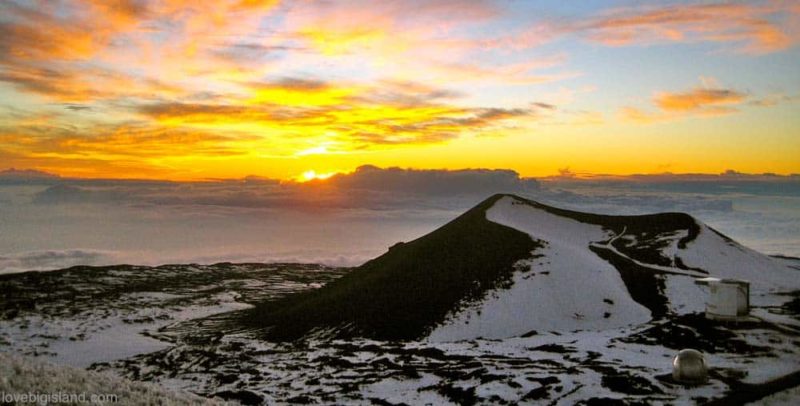
Sunsets from the MaunaKea summit are without exception breathtaking. Here you can see the JCMT and CSO telescopes, a snowy cinder cone and the sun setting below the clouds (not the ocean!)
Free Stargazing Program at the Visitor Center
What changed? As of 2023 the free stargazing program has resumed with some important changes. It now is a monthly event and reservations are required.
Twice a month staff member at the VIS organize a free stargazing event. One of these events is open for everyone, and one is reserved for Kamaʻaina (in possession of a valid state ID), These events are free to attend for locals and visitors alike, but reservations are required and availability is limited.
What happens during the free stargazing program?
The program starts with a check-in with visitor center staff just before sunset. This gives you enough time to enjoy the sunset from Puʻukalepeamoa – a hill close to the visitor center and a GREAT viewpoint for sunsets.
After enjoying the sun set on top of the clouds, you’ll meet a staff member back at the visitor center and take a short walk to a private stargazing location where the telescopes will be set up. You’ll enjoy two hours of viewing with knowledgeable staff and volunteers enjoying galaxies, nebulae, planets, constellations and more!
How to register
Signing up is easy – just fill out the web form here. Reservations can only be made for the next stargazing event, and open on noon of the day of the current event. For example, reservations for the August 17, 2023 event will open at 12:00 PM HST on July 13, 2023.
- The Kamaʻaina Stargazing Event is typically held on the 3rd Saturday of each month
- The General Stargazing Event is typically held on the 4th Monday of each month.
Each adult may register up to two children under 18, and children under 18 do not count against the registration cap. Individual registrations are restricted to once/3 months.
Upon signing up and securing your reservation, you’ll receive a confirmation email with more details about the event. You will need your ID in order to check in at the VIS. At night, local volunteer astronomers set up telescopes outside of the station and let visitors use them under supervision as part of their free stargazing program (website).
Did you know: that you can actually see more stars from the visitor station than from the Maunakea summit? Your vision at the summit is less acute because of the lack of oxygen there, meaning you can see less stars even though your are at higher elevation. Telescopes are obviously not bothered by a lack of oxygen so the summit *is* the best place for them.
How to visit the MaunaKea summit yourself
There are two logical destinations on MaunaKea if you want to visit for stargazing: the visitor station halfway up the volcano and the telescopes at the summit. You can reach the visitor station with any car. To get all the way to the summit you need a 4WD vehicle with good brakes to navigate the steep and winding gravel road to the summit.
In this section we discuss:
- How to get up to the MaunaKea Visitor Center (MKVIS)
- How to drive up to the Maunakea summit
- Seeing the sunset: from the visitor center and from the summit.
- The free stargazing program at the VIS (once a month, advance reservations limited and required)
Ps. going to the summit yourself requires a 4WD car and good driving skills, so many people prefer joining a tour to the summit.
How to drive to the MaunaKea Visitor Information Station (MKVIS)
To reach the visitor station (website) follow Saddle Road (Hwy 200) until you get to the Mauna Kea access road (around mile marker 28, across the street from the Puʻu Huluhulu Cinder cone parking lot) and follow that road up. The visitor center is located ~halfway up the volcano at 9,200 ft elevation. Make sure that you have a full tank of gas before you start the ascent, as the nearest gas station is ~35 miles (50 km) from the visitor station.
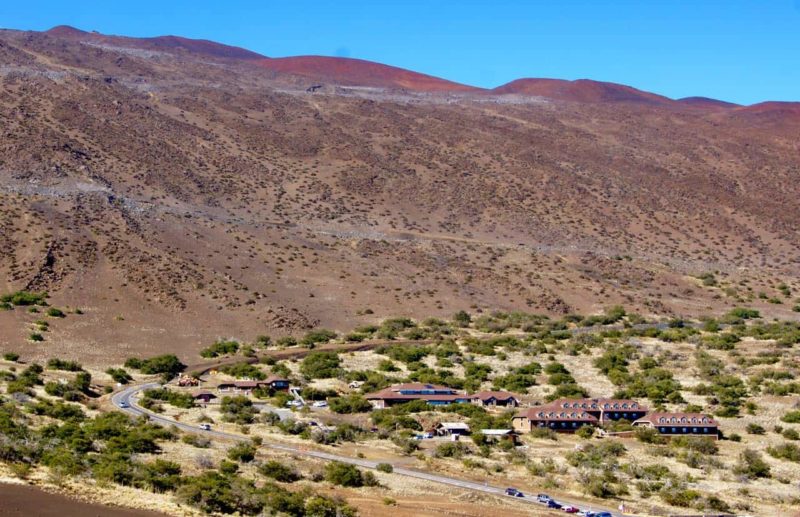
A view of the Onizuka Center for International Astronomy Visitor Information Station on the ascent of MaunaKea, taken from a Puʻu at the 9300 ft. level. Credit: Madereugeneandrew – Own work, CC BY-SA 4.0
Did you know? The visitor information station is officially called the “Onizuka Center for International Astronomy Visitor Information Station”. It was named after the Hawaiʻi-born astronaut Ellison Onizuka who died in the Space Shuttle Challenger disaster in 1986.
The purpose of the visitor center is to educate the visitors on the cultural importance of the mountain. You can also watch a video about astronomy in the center, and find a small shop where you can buy souvenirs, hot and cold drinks, and snacks.
Please be aware of the possibility of long lines and scarce parking at the Visitor Information Station (VIS) on these evenings until ~1.5 hours after sunset. Parking at the VIS is available for up to 115-vehicles on a first-come, first-served basis. Once the parking lots are full, all vehicles will be turned away.
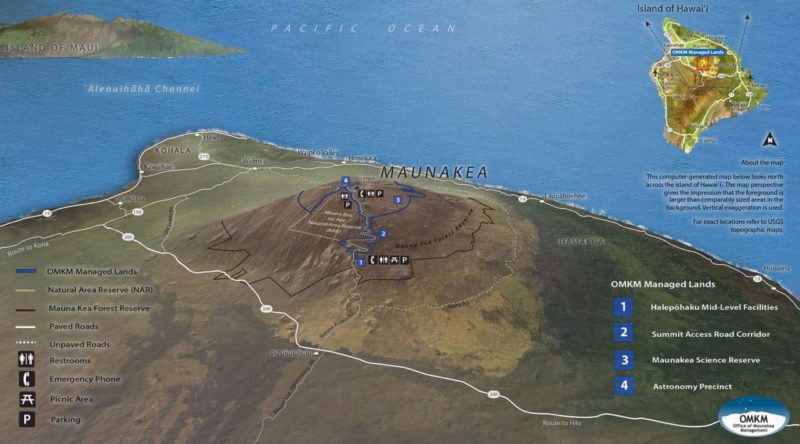
Directions from Kona (64 mi) and Hilo (43 mi) to the summit of MaunaKea. Be aware that you need to stop at the visitor center for a while to help your body acclimatize to the large altitude difference between Kona/Hilo and the summit (13,796 ft). Image credit: OMKM
How to drive to the MaunaKea summit yourself: 8 things to know
You can visit the summit and see the telescopes during daytime and stay for up to 30 minutes after the sun has set. Take the following things into account when doing so:
- Please be respectful. To Hawaiians the summit of MaunaKea is sacred: it is the place where Poli‘ahu (the goddess of snow) lives.
- You need a 4WD vehicle to drive to the summit of MaunaKea. No 2-wheel drive vehicles are allowed past the end of the paved road just above the VIS.
- Stop for at least half an hour at the visitor station to acclimatize to the altitude. The summit is at 4,205 m (13,796 ft) elevation and high altitude carries serious health risks, most of which can be mitigated by a short stop.
- Sometimes the summit road is closed due to bad weather. The observatories at the Mauna Kea summit maintain a website showing the conditions of the road up to the summit. Please have a look here to see if the road is open and to find out what conditions you can expect. High winds, ice, and snow on the road are all within the realm of possibility.
- You cannot use the telescopes on the summit or to enter the buildings. ~30 minutes after sunset the summit becomes off-limits and visitors are expected to drive down.
- The Subaru telescope organizes visits to its telescope during daytime. There is limited availability but, especially if you like planning ahead, this could be something for you. See the ” visiting the Subaru telescope” website for more information.
- Scuba diving and high altitude visits are extremely incompatible. Wait at least 24 hours before going to the summit after you have been scuba-diving. Snorkeling is no problem.
- Dress warm! After the sunset temperatures can drop as low as 30-40 degrees F (between -1 and +4 Celsius). Also, make sure to bring enough snacks, sunscreen, and water.
In the following informative 6-minute video you can see how two Oʻahu residents, Devon and Irina, make it to the Mauna Kea summit themselves:
Devon and Irina have their own very informative Youtube channel Just be Out about visiting Oʻahu, so check them out if you are planning to go there and you like their style.
Seeing the sunset from Maunakea (from the summit vs. from the visitor center)
If you are looking for an epic sunset spot Maunakea should definitely be on your list. The best sunset viewing is from the summit but getting there is difficult because you need to either have a 4WD vehicle or join a tour. A good alternative to the summit is to see the sunset from the visitor center.
We discuss both options below.
Seeing the sunset from the Maunakea summit
The Maunakea summit is in our opinion one of the best places to see the sunset on Hawaiʻi, and considering the competition that says a lot! You can see the sun dip below the clouds in a spectacular explosion of color, framed by (snowy) peaks, old volcanoes, and futuristic world class telescopes.
To get to the summit you either need to join a tour (see below) or drive a 4WD vehicle. The 4WD requirement is for good safety reasons (brakes overheating on the way down) and park rangers often check the cars on the summit road. Scroll up for 8 tips on how to drive to the summit yourself.
Make sure to dress warm (many layers) and bring a good camera because it gets really cold up there as soon as the sun is gone.
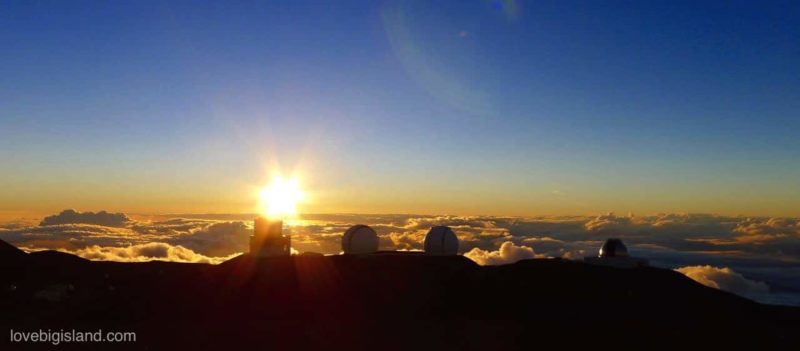
Telescopes of the MaunaKea Observatory, Hawaii. From left to right: the Subaru Telescope, the W. M. Keck Observatory (2 domes), and the NASA Infrared Telescope Facility
Seeing the sunset from the Mauna Kea Visitor Information Station (VIS)
Seeing the sunset from the Mauna Kea visitor center is a good alternative is you do not want to go all the way to the summit. There are cinder cones that block the view of the sunset from the visitor center itself, but you can get to a good sunset viewing spot close-by with an easy hike.
Parking at the visitor center is limited and it gets busy here around sunset, so make sure to arrive early. Make also sure to bring warm clothes and a windbreaker to stay comfortable as it can get cold and windy.
MaunaKea facts and trivia
MaunaKea last erupted more than 4,000 years ago and is no longer considered an active volcano. The MaunaKea summit is the highest point of the state of Hawaiʻi at 13,796 ft above sea level. There have even been glaciers on the volcano during past colder periods (source).
If you like stargazing you should definitely have a look at our astronomy calendar for Hawaiʻi to see if there is a meteor shower or any other good excuse to make looking up at the stars special during your stay.
